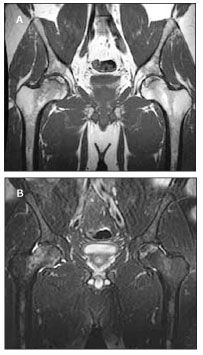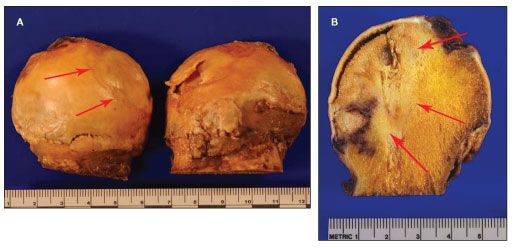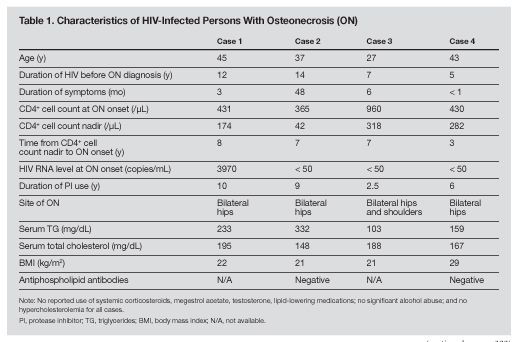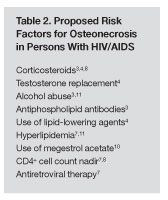- Clinical Technology
- Adult Immunization
- Hepatology
- Pediatric Immunization
- Screening
- Psychiatry
- Allergy
- Women's Health
- Cardiology
- Pediatrics
- Dermatology
- Endocrinology
- Pain Management
- Gastroenterology
- Infectious Disease
- Obesity Medicine
- Rheumatology
- Nephrology
- Neurology
- Pulmonology
Osteonecrosis in HIV-Infected Persons: Radiographic Findings Delay Clinical Diagnosis
Patients with HIV infection demonstrate an unexpectedly high incidence of bone-related disorders, most notably osteonecrosis
As survival and quality of life has improved in HIV-infected patients, in large part because of the availability of potent antiretroviral therapy, the focus of clinicians has appropriately shifted to the management of metabolic complications and previously unrecognized drug toxicities. Patients with HIV infection demonstrate an unexpectedly high incidence of bone related disorders ranging from osteoporosis to, most notably, osteonecrosis of the hip.1,2 Some report the incidence of osteonecrosis of the hip to be as much as 45 times greater in HIV-infected persons than the general population.3 In one study, 4% of asymptomatic HIV-infected patients had osteonecrosis on screening MRI. Use of lipid-lowering agents, systemic corticosteroids, testosterone replacement, and anticardiolipin antibodies and engaging in bodybuilding may correlate with increased risk of osteonecrosis in HIV-infected patients.4 We describe 4 HIV-infected patients with osteonecrosis for whom reliance on plain radiographs for the diagnosis was misleading and resulted in a delay in diagnosis of several months.
CASE SUMMARIES
Case 1
A 45-year-old black man with a 12-year history of HIV infection presented with a 3-month history of groin pain. His CD4+ cell count was 431/µL (21%), and his HIV RNA level was 3970 copies/mL. Antiretroviral therapy included didanosine, tenofovir, and lopinavir/ritonavir. Findings on bilateral hip radiographs were normal. Two months later, after pain persisted, an MRI scan revealed early bilateral osteonecrosis of the hips. One year later, pain has been managed with a narcotic analgesic. His CD4+ cell count nadir was 174/µL (16%) approximately 8 years before the onset of symptoms. The patient had taken a protease inhibitor (PI) for 10 years. There were no identifiable risk factors for osteonecrosis.
Case 2
A 37-year-old white man with a 14-year history of HIV infection presented with a 4-year history of right thigh pain, which was initially diagnosed as ileotibial band syndrome. His CD4+ cell count was 365/µL (12%), and his HIV RNA level was below 50 copies/mL. His antiretroviral therapy included lamivudine, stavudine, and nevirapine. Findings on bilateral hip radiographs were normal at that time. Pain persisted intermittently, and after osteonecrosis was suspected, a repeated MRI scan 3 years later revealed a normal right hip.
One year later, findings on repeated hip radiographs were normal, but repeated MRI scans showed bilateral osteonecrosis of the femoral heads. The patient became wheelchair-bound because of his excruciating pain despite narcotic analgesic use. A right total hip replacement and left hip core decompression were performed to control his pain after continued disease progression. One year later, after pain persisted in his left hip, a left total hip replacement was performed, with successful results. His CD4+ cell count nadir was 42/µL (4%) reported 7 years before the onset of symptoms. The patient had mild hypertriglyceridemia but no other identifiable risk factors for osteonecrosis. He had taken a PI for 9 years.
Case 3
A 27-year-old black man with a 7-year history of HIV infection presented for evaluation of bilateral inguinal pain. His CD4+ cell count was 960/µL (36%), and his HIV RNA level was below 50 copies/mL. Antiretroviral therapy included didanosine, tenofovir, and ritonavir-boosted atazanavir. Findings on bilateral hip radiographs were normal. Symptoms persisted, and an MRI scan done 5 months later revealed bilateral osteonecrosis. Repeated hip radiographs also showed osteonecrosis. Three months later, bilateral shoulder pain developed. Bilateral shoulder radiographs were significant for osteonecrosis of the humeral head. Pain has been managed with narcotic analgesics. His CD4+ cell count nadir was 318/µL (20%) reported 7 years before the onset of symptoms. The patient had taken a PI for 2.5 years. No risk factors for osteonecrosis were noted.
Case 4
A 43-year-old white man with a 5-year history of HIV infection presented with a 2-week history of right upper thigh pain. His CD4+ cell count was 430/µL (43%), and his HIV RNA level was below 50 copies/mL. Antiretroviral therapy included abacavir, tenofovir, and ritonavir-boosted atazanavir. Findings on bilateral hip radiographs were normal. Three weeks later, after his pain persisted, an MRI scan revealed bilateral femoral head osteonecrosis (Figure 1).

Figure 1. T1-weighted (A) and T2-weighted (B) MRI scans of bilateral hips of patient described in Case 4, showing serpiginous lines of dark signal within the femoral heads and moderate bone marrow edema in the right femoral neck, consistent with osteonecrosis.
Repeated hip radiographs at that time showed smudging of the bilateral femoral heads, consistent with early osteonecrosis. The patient underwent right hip core decompression, which was unsuccessful in controlling his pain. He subsequently underwent a right total hip replacement a few months later after suffering unrelenting pain (Figure 2). His CD4+ cell count nadir was 282/µL (30%) reported 3 years before the onset of symptoms. The patient had taken a PI for 6 years. No risk factors for osteonecrosis were noted.

Figure 2. Surgical pathology (femoral head of patient described in Case 4) showing slightly depressed articular surface (A) and crescent-shaped area of infarction at epiphyseal and subarticular regions in cross-section (B).
DISCUSSION
Clinicians caring for HIV-infected patients should be aware that in early osteonecrosis, findings on plain radiographs may be normal in up to 60% of patients.5 In all 4 of our cases, initial plain radiographs of the involved joints did not show osteonecrosis, even though the patients were profoundly symptomatic. In addition, curiously, 2 of our patients complained of thigh pain rather than the classic inguinal discomfort commonly associated with hip disease.
An increased incidence of previously recognized risk factors for osteonecrosis in other patient populations, such as corticosteroid use, hypercoagulable states (anticardiolipin antibodies), and alcohol abuse, has been associated with osteonecrosis in HIV-infected patients. In addition, other reported risk factors include testosterone replacement, use of megestrol acetate, the presence of lipodystrophy syndrome, and use of lipid-lowering agents.3,4,6-10 Most reports of osteonecrosis in HIV-infected patients have identified the presence of one or more recognized risk factors, especially the use of systemic corticosteroids, although in some of these patients, no risk factors could be identified.4,7,9-11
None of our patients possessed these reported risk factors for osteonecrosis in HIV infection, except for one who had mild hypertriglyceridemia; however, all had a prolonged duration of HIV infection and exposure to antiretroviral therapy, particularly to PIs (Table 1).

The current data on whether PIs or other antiretroviral drugs are independently associated with the development of osteonecrosis are inconclusive,3,4,6-8 although it appears that the incidence of osteonecrosis among HIV-infected patients increased after the introduction of highly active antiretroviral therapy. A French study showed that the risk of symptomatic osteonecrosis increased with the duration of HIV infection and antiretroviral therapy. However, others report conflicting data on whether HIV infection itself or antiretroviral exposure acts as an independent risk factor for osteonecrosis.7,8 Similarly, several studies have reported that a lower CD4+ cell count nadir (under 50/µL) and a brisk immune response appeared to be associated with a higher incidence of osteonecrosis, but other research could find no consistent association between osteonecrosis and CD4+ cell count or HIV RNA level.4,7,8,12
Some researchers have postulated that chronic inflammation in the context of prolonged HIV infection may contribute to the development of osteonecrosis, as has been suggested in relation to systemic lupus erythematosus.12,13
While many of the reported risk factors are intriguing, there is a lack of controlled data from published studies to support many of the proposed associations (Table 2).

The incidence of osteonecrosis may be underestimated in persons with HIV/AIDS. A recent natural history study reports incidence data that suggest a 100-fold higher estimated incidence in the HIV-infected population than in the general population. In addition, there appears to be a more rapid progression of disease in patients with symptomatic osteonecrosis, in that 60% of patients had progression to the extent of requiring total hip replacement.12
The lack of previously recognized risk factors for the development of osteonecrosis and normal findings on radiographs should not preclude further evaluation for this condition with MRI scanning.
CONCLUSION
Osteonecrosis appears to be yet another complication of HIV disease, its related therapies, or both, with a potential for considerable morbidity. Unfortunately, this disease typically requires surgical intervention for optimal management. Clinicians should maintain a high index of suspicion for osteonecrosis in this patient population in cases of unexplained bone pain or persistent groin pain. Negative findings on plain radiographs have proved unreliable, and if symptoms persist, a timely MRI scan is indicated. Given the high incidence of osteonecrosis in HIV infection, unexplained osteonecrosis should prompt HIV screening, particularly in the absence of any identifiable risk factors.
Acknowledgment: We would like to acknowledge Katie Sanders for technical assistance in preparing the figures.
No potential conflict of interest relevant to this article was reported by the authors.
References:
References
1.
Amorosa V, Tebas P. Bone disease and HIV infection.
Clin Infect Dis.
2006;42:108-114.
2.
Mondy K, Tebas P. Emerging bone problems in patients infected with human immunodeficiency virus.
Clin Infect Dis.
2003;36(suppl 2):S101-S105.
3.
Brown P, Crane L. Avascular necrosis of bone in patients with human immunodeficiency virus infection: report of 6 cases and review of the literature.
Clin Infect Dis
. 2001;32:1221-1226.
4.
Miller KD, Masur H, Jones EC, et al. High prev-alence of osteonecrosis of the femoral head in HIV-infected adults.
Ann Intern Med
. 2002;137:17-25.
5.
Conklin JJ, Alderson PO, Zizic TM, et al. Comparison of bone scan and radiograph sensitivity in the detection of steroid-induced ischemic necrosis of bone.
Radiology
. 1983;147:221-226.
6.
Allison GT, Bostrom MP, Glesby MJ. Osteonecrosis in HIV disease: epidemiology, etiologies, and clinical management.
AIDS
. 2003;17:1-9.
7.
Mary-Krause M, Billaud E, Poizot-Martin I, et al. Risk factors for osteonecrosis in HIV-infected patients: impact of treatment with combination antiretroviral therapy.
AIDS
. 2006;20:1627-1635.
8.
Glesby MJ, Hoover DR, Vaamonde CM. Osteonecrosis in patients with human immunodeficiency virus: a case-control study.
J Infect Dis.
2001;184:519-523.
9.
Monier P, McKown K, Bronze MS. Osteonecrosis complicating highly active antiretroviral therapy in patients infected with human immunodeficiency virus.
Clin Infect Dis
. 2000;31:1488-1492.
10.
Koller E, Mann M, Malozowski S, et al. Aseptic necrosis in HIV seropositive patients: a possible etiologic role for megestrol acetate.
AIDS Patient Care STDs
. 2000;14:405-410.
11.
Scribner AN, Troia-Cancio PV, Cox BA, et al. Osteonecrosis in HIV: a case-control study.
J Acquir Immune Defic Syndr.
2000;25:19-25.
12.
Morse CG, Mican JM, Jones EC, et al. The incidence and natural history of osteonecrosis in HIV-infected adults.
Clin Infect Dis.
2007;44:739-748.
13.
Lane NE. Therapy insight: osteoporosis and osteonecrosis in systemic lupus erythematosus.
Nat Clin Pract Rheumatol.
2006;2:562-569.
